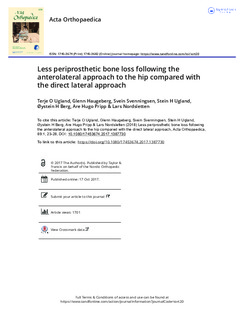| dc.contributor.author | Ugland, Terje | |
| dc.contributor.author | Haugeberg, Glenn | |
| dc.contributor.author | Svenningsen, Svein | |
| dc.contributor.author | Ugland, Stein Håvard | |
| dc.contributor.author | Berg, Øystein Hjalmar | |
| dc.contributor.author | Pripp, Are Hugo | |
| dc.contributor.author | Nordsletten, Lars | |
| dc.date.accessioned | 2019-04-05T14:43:55Z | |
| dc.date.available | 2019-04-05T14:43:55Z | |
| dc.date.created | 2018-07-04T13:53:16Z | |
| dc.date.issued | 2018 | |
| dc.identifier.citation | Acta Orthopaedica. 2018, 89 (1), 23-28. | nb_NO |
| dc.identifier.issn | 1745-3674 | |
| dc.identifier.uri | http://hdl.handle.net/11250/2593578 | |
| dc.description.abstract | Background and purpose — The loss of bone mineral in the proximal femur following hip arthroplasty may increase the fracture risk around uncemented stems. We hypothesized that the surgical approach to the hip might influence bone mineral changes around the femoral stem in patients with a femoral neck fracture (FNF).
Patients and methods — This was a pre-specified subgroup analysis (n = 51) of an ongoing randomized trial (n = 120) in patients with FNF. Participants were allocated to an uncemented hemiarthroplasty inserted through a direct lateral (Hardinge) approach or an anterolateral (modified Watson-Jones) approach. The 51 patients (mean age 83 (70–90) years, 33 women) were measured by dual-energy X-ray absorptiometry (DXA) to assess changes in periprosthetic bone mineral density (BMD).
Results — The mean change in total BMD differed between groups at 12 months in favor of the anterolateral group (4.8%, 95% CI 0.0–9.6; p = 0.05). DXA at 3 months displayed BMD loss in the proximal Gruen zones in the lateral group compared with the anterolateral group. Zone 1 (–5.0% vs. 2.7%), zone 2 (–4.3% vs. 4.1%), zone 6 (–6.5% vs. 0.0%) and zone 7 (–11% vs. –2.4%, all p < 0.05).
Interpretation — DXA measurements in this study indicate that surgical approach to the hip influences periprosthetic BMD. Clinical implications remain uncertain. Our conclusions should be interpreted with caution as we did not perform adjustments for multiple tests, possibly leading to inflation of false-positive findings. | nb_NO |
| dc.language.iso | eng | nb_NO |
| dc.publisher | Taylor & Francis | nb_NO |
| dc.rights | Navngivelse-Ikkekommersiell 4.0 Internasjonal | * |
| dc.rights.uri | http://creativecommons.org/licenses/by-nc/4.0/deed.no | * |
| dc.title | Less periprosthetic bone loss following the anterolateral approach to the hip compared with the direct lateral approach: A subgroup analysis from a randomized trial in patients with a femoral neck fracture | nb_NO |
| dc.type | Journal article | nb_NO |
| dc.type | Peer reviewed | nb_NO |
| dc.description.version | publishedVersion | nb_NO |
| dc.source.pagenumber | 23-28 | nb_NO |
| dc.source.volume | 89 | nb_NO |
| dc.source.journal | Acta Orthopaedica | nb_NO |
| dc.source.issue | 1 | nb_NO |
| dc.identifier.doi | 10.1080/17453674.2017.1387730 | |
| dc.identifier.cristin | 1595664 | |
| dc.description.localcode | © 2017 The Author(s). Published by Taylor & Francis on behalf of the Nordic Orthopedic Federation. This is an Open Access article distributed under the terms of the Creative Commons Attribution-Non-Commercial License (https://creativecommons.org/licenses/by-nc/3.0) | nb_NO |
| cristin.unitcode | 194,65,30,0 | |
| cristin.unitname | Institutt for nevromedisin og bevegelsesvitenskap | |
| cristin.ispublished | true | |
| cristin.fulltext | original | |
| cristin.qualitycode | 1 | |

